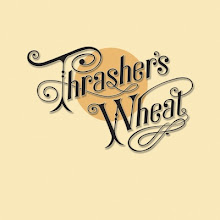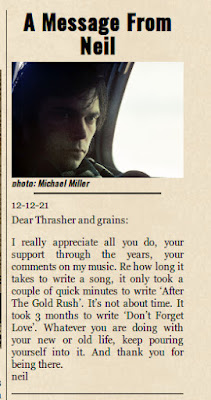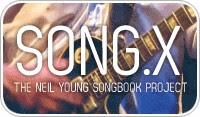A Few Thoughts on Album Early Daze by Neil Young and Crazy Horse
Here are a few thoughts on Early Daze by Neil Young and Crazy Horse by Scotzman.
“There’s no real murder in it.”
That’s what Neil Young once said about Down By The River, in its early daze.
Oh, many versions since—including, for example, the lunatic version from Dallas 1989—are vicious enough to make us question whether the narrator of the song has a body stashed underneath his bedroom floorboards.
But that’s in the future. Listening to the newly-released edit of the original 1969 studio version of Down By The River (the same band performance, but with an early lead-vocal overdub and different backing vocals), there’s not only no murder, there’s no suspicion of murder, either.
It’s sensitively performed. But Lieutenant Columbo stays home with his wife.
1969 feels like a different era… a very different era. Bassist Billy Talbot and drummer Ralph Molina are 25 years old. Neil Young is still 23, and is decades away from writing Cocaine Eyes, Eldorado or Rockin’ In The Free World.
Even Like A Hurricane doesn’t exist! Neither do the big Rust-era “amplifiers”.
Mirrorball hasn’t been recorded yet; the members of Pearl Jam are only about 3 years old.
For those of us either not yet born or still very young in 1969, it’s a time we don’t remember, but instead *imagine*. We see it on a movie screen in our minds. Palm trees, bright sun, classic American cars, a slightly gritty and grainy picture. The music on Early Daze is the soundtrack.
In 1969, Neil is still finding his range as a performing artist. He’s still discovering he can play different characters, each representing a different part of his psyche.
But more than that, there’s a through-and-through innocence to the sound of these recordings. Jangly and bright and care-free. Slipping down as easy as honey liqueur, with a touch of edge as the alcohol hits.
A rolling start.
Before super-fame. Before the fed-into-the-waste-disposal-machine grind of the Time Fades Away tour.
Back when Danny Whitten was still alive.
Consider: If we were to make a two-part movie about Neil Young’s career (working title: “Before and After”), where would we put the dividing line… the gap between before and after?
One temptation, I think, would be to start ‘part two’ in 1996: just after Neil’s producer David Briggs died.
But of course, Briggs’s immense influence on Neil’s music has carried on beyond his death. That’s why a recording like, say, Walk Like A Giant has such spiritual guts to it. Because others—not least guitarist Poncho Sampedro—have carried the torch and kept the spirit alive.
Instead, perhaps, the second film should begin with the aftermath of Danny Whitten’s death in 1972.
Because that’s when everything changes. That’s when the sun goes in, and when the chilled and relentless rain falls into greasy urban puddles.
Listen to Winterlong on Early Daze… then listen to the agonized (and perhaps artistically superior) version on Decade — recorded after Danny’s death.
Listen to Heart of Gold on Harvest… then listen to the grating, tone-deaf din of Tuscaloosa.
Listen to the newly-released Down By The River, innocent at heart…. then watch the thrilling slasher version from Concord 1993.
Listen to Come On Baby Let’s Go Downtown… then listen to Mellow My Mind.
Listen to Leave the Driving (a story of drug-related death/murder) and Carmichael (a story of the ensuing grief).
It’s not just the “ditch” period. It’s everything since Danny died. The music—metaphorically, at least—is haunted.
In the early seventies, Danny Whitten was a very sick man. He needed help, and he didn’t get it. That’s the tragedy. It’s no wonder the next few years of Neil Young music are so bleak, so tortured.
Drummer Ralph Molina said “we should’ve been able to do more for Danny”. And on one level, maybe he’s right.
But of course, it’s near-impossible for any one person to know *how* to help. How, exactly, do you help a man addicted to heroin? It’s not a question most of us—self included—are trained how to answer.
It’s a bit like the question “how do you help a family member who is clinically depressed”?
Everybody wants to help… nobody (other than a trained specialist) knows how. The end result is that nothing gets done, with no malicious intent whatsoever.
I know Neil has blamed himself, so has Ralph, so have Danny’s other friends. That’s because they are good people who care. Not because they’re actually to blame.
It’s one of those situations where we wish we could change the past, but can’t. Nobody intended for Danny to die, but that didn’t stop it happening.
In 1973, “all that glitters is not gold”. “Everything’s cheaper than it looks”. Neil Young has found fame, but the trappings of fame have made him unhappy. And along with his bandmates, he feels a great deal of guilt about Danny’s death. Tequila and art take the place of therapy sessions, and one way or another, the survivors find a way through.
Here’s Neil himself, speaking to biographer Jimmy McDonough about the end of the early daze of Crazy Horse:
“We knew what we had. We all knew it was really good. Then to see it get f**ked up was really depressing. Seeing drugs come in and f**k it up, seeing the whole thing just go downhill. The inexperience of not knowing how to deal with heroin use, not knowing what it was, being too young for certain kinds of decisions. But that was the hand I was dealt at the time. The destruction of Danny’s life…”.
The Early Daze album, meanwhile, comes before. Bright and relaxed; chilled out, with an effortless rock ‘n’ roll edge. Neil records with his show-biz buddies CSN—his day job, of sorts—and then has fun playing with Crazy Horse in his spare time.
The in-studio banter is relaxed and charming and inviting; the music, too. It’s a record that documents a band enjoying the journey of making art for its own sake. With David Briggs in the control room: the ringleader, the motivator. Another unseen and much-missed member of Crazy Horse.
And with Danny Whitten still alive, still healthy, sharing the spotlight, playing and singing beautifully, for us all to hear and enjoy.
-Scotsman.
Labels: @CrazyHorse4HoF, album, crazy horse, neil young, Neil Young and Crazy Horse, review
































 Human Highway
Human Highway

















 Concert Review of the Moment
Concert Review of the Moment





 This Land is My Land
This Land is My Land

 FREEDOM In A New Year
FREEDOM In A New Year









 *Thanks Neil!*
*Thanks Neil!*




![[EFC Blue Ribbon - Free Speech Online]](http://www.thrasherswheat.org/gifs/free-speech.gif)











 The Unbearable Lightness of Being Neil Young
The Unbearable Lightness of Being Neil Young Pardon My Heart
Pardon My Heart



 "We're The Ones
"We're The Ones  Thanks for Supporting Thrasher's Wheat!
Thanks for Supporting Thrasher's Wheat!




 This blog
This blog 
 (... he didn't kill himself either...)
#AaronDidntKillHimself
(... he didn't kill himself either...)
#AaronDidntKillHimself









































































 Neil Young's Moon Songs
Neil Young's Moon Songs




 Civic Duty Is Not Terrorism
Civic Duty Is Not Terrorism Orwell (and Grandpa) Was Right
Orwell (and Grandpa) Was Right


 What's So Funny About
What's So Funny About 



15 Comments:
Thanks Scots, as always!
And from our pal Davy...
Hi pal!
Here's the obligatory Early Daze vid - what a release!
Cheers,
Davy
https://www.youtube.com/watch?v=VLjL5g0UfnQ
Very good Early Daze here on TW from both Scotzman and Dan… one of the understated charms of this release is getting to get aural “glimpse” into early Horse sessions. Aside from Danny Whitten’s crucial presence, it’s not too different from the fragments of banter included between songs on World Record (2022).
The Horse’s Winterlong sounds, to me, somewhat Byrds-influenced with jangly guitar. But I felt the POTR live recording from Noise & Flowers was *the* version—I’m prepared to be in a minority on that one.
I’ve already started toying combining EKTIN and Early Daze cuts into a hypothetical double album. Naughty, I know…. maybe I should take the album as is. I just feel the need to hear Cowgirl alongside these songs.
My review will be posted on Friday.
wardo
everybodysdummy.com
No one in their twenties is capable of dealing with addiction, let alone anything else for that matter. I feel bad that Danny’s friends feeling somehow responsible for his death. Even Danny didn’t know that the drug was deadly, he was just a kid like the rest of them. Same goes for Jim, Janis, and Jimi. Not to mention dozens of other victims; both well known and unknown. They were just kids, all of them. The culture of the times was far more responsible for them dying than any one person. We all know more now, and hindsight is almost always 20/20. Or at least it should be.
As for a movie of Neil’s life….. well that would require more than a trilogy. He has had so many changes throughout this career that deserve attention. Each one would deserve its own movie. I still feel that Neil is one of only a few artists from the sixties that has remained relevant throughout his entire career. He’s just in a class by himself.
Early Daze captures the spirit of the times beautifully. Those moments are fleeting, so it’s just a blessing it was captured on tape. A blessing for all of us.
Peace 🙏
Dan’s in tune with the spirit of the music (IMO). Maybe a series—hard for me to imagine a successful movie of NY’s life. These days, everything’s a “limited series” on Netflix or (heaven forbid) Amazon Prime. Speaking generally, though, I’m not very excited about a lot of biography movies. There’s too much hagiography and just glossing over the messiness of a real human.
Occasionally you see a biopic that does something fresh. The recent Weird Al movie (“Weird”) was a satire of the whole genre. Remembering the ersatz quality of NY’s own forays into cinema, I’d rather an NY bio with some of the Bernard Shakey ethos in it. As far as Hollywood goes, that seems unlikely for reasons of profit and prestige.
(Btw, this is not to harp on peripheral details but to keep opening out conversations.)
Twenty y.o.’s are definitely ill equipped to deal with drug use/abuse. But that is the deception of drugs. @ ANY age. You may start out feeling relief from whatever ails you. But the insidious nature of the beast is the tolerance and, ultimately, dependency. I’ve lost many friends. No one is immune. Sad.
On the subject of partitioning NY’s career. Look to the Archives, by volume. The man himself is about to release Volume three. Has discussed a fourth and hinted at a fifth. And something tells me a sixth volume could be the “After” (or to be continued volume). Lord knows the man’s output seems without bounds. Only Neil knows what the vaults OR the future, holds in store.
The music becomes "haunted." Scotsman brings up themes that allow us to gather a compelling story. Maturing from a trauma like Danny Whitten's death is categorically distinct from any sort of normative maturation process. Mortality, and the edges it puts on and takes off, are always apparent in Neil's best music. When he is totally with the muse, songs are stripped of sentimentality.
"Soldier" is a song that pulls all the usual emotive baggage from the notion of a savior. It deflates the myth into the mode of sheer mortality: the pain we absolutely need to feel.
"Don't Cry" obliterates all excuses and turns a sharp eye on the self. He is haunted by his "big lies."
As maybe we should all be.
I’m interested in how we distinguish sentimentality from a more substantial, nuanced emotional connection or resonance. Is it, to some degree, in the mind of the beholder? It’s possible to present the same song (identical words and tune) in different settings that totally alter the effect. The listener’s experience comes from the way any number of components, artistic decisions, layer with each other.
Personally, I’ve found more syrupy production to distract from the emotional core of a song. Parts of Comes a Time, Harvest Moon, or Prairie Wind come to mind. On the other hand, one could accuse Storytone of sounding over-lush yet the orchestral arrangements fit (mostly) hand in glove with the songs. I think part of the puzzle lies in the use (and misuse) of genre conventions, which can easily scan as cliched and superficial. Stylization is key but problematic. A lot rides on why, and how, an artist does it. This can make the difference between a fresh, insightful experiment in form vs. a lazy pastiche.
Early Daze would have been one of the great LPs of 1969 or 1970. today, however, too many of the songs are too familar to me==perhaps because there is little difference between the ED and released versions.
I would have liked to hear this LP, from corner of ATGR lyic sheet.
1. Oh lonesome me
2. Wonderin'
3. Everybody's Alone
4. Sugar Mtn
5. Sea of Madness
6. Big Waves
7. Dance, Dance, Dance
8. Birds
9. I need her love to get by
NOTE: All of these songs may be in Archives I (or II?). IDK cuz this retiree can't aford them. I don't believe I've heard Big Waves or I need her sove to get by.
thoughts?
If anyone didn’t know, “Big Waves” became Powderfinger—the earliest recordings I’ve heard are Zuma/Hitchhiker era. Found this article: https://faroutmagazine.co.uk/understanding-lyrics-neil-young-powderfinger/. Plenty of fluff and more summary than close reading, but some worthwhile quotes from NY toward the bottom. The song gives me images of Prohibition-era moonshiners or drug traffickers. “Another delivery of chemicals and sacred roots.”
I think MR that reasonably objective criticism can reveal sentimentality as opposed to emotional realism/depth. Sentimentality is often tightly woven with nostalgia, which is another fatality to art. (Check out Heidegger's essay "Art and Truth.")
Abner, thanks for the Heidegger recommendation. You’ve probably gathered that my background is English lit. That probably explains my preoccupation with Aesthetics, which can come across as detail-obsessed. Searching for meaning through form can lead to fixing on mundanities: the perils of Deconstruction and close reading. There are reasons Derrida described the supplement as “dangerous.” It’s a classic problem of missing the forest for the trees.
While you are at it (checking out Hy-Decker, I mean) I recommend also looking at the concept of "kitsch" and its various defintions or rather attempts to define what kitsch is. Some of the syrupy products by Neil Young definitely fulfill some of the criteria for kitsch if one subtracts the self-irony served on top.
The US, from a cultural perspective, has a constrained (I want to say "stunted") sense of irony. Looking at some of our leading public figures, it's not shocking that self-recognition would be irksome. We have plenty that would qualify as kitsch--but it's not always recognized as such. Highly self-aware kitsch becomes something like camp, which is commonly associated with particular subcultures many people (unfortunately) still out of their way to dissociate from.
TMR: your first comment inspired me to give Noise and Flowers another listen. Maybe not my all-time favourite Winterlong, but a very decent one to the classic blueprint.
NYBD11-12: interesting tracklist! Again with an unmistakable 1969/1970 feel: can't imagine this series of songs (or one with the same "feel") in 1989 or even (especially) 1973.
Great to see the comments section in full flow and covering a lot of really interesting ground. Thanks everybody. And special thanks Thrasher.
Scots.
Post a Comment
<< Home